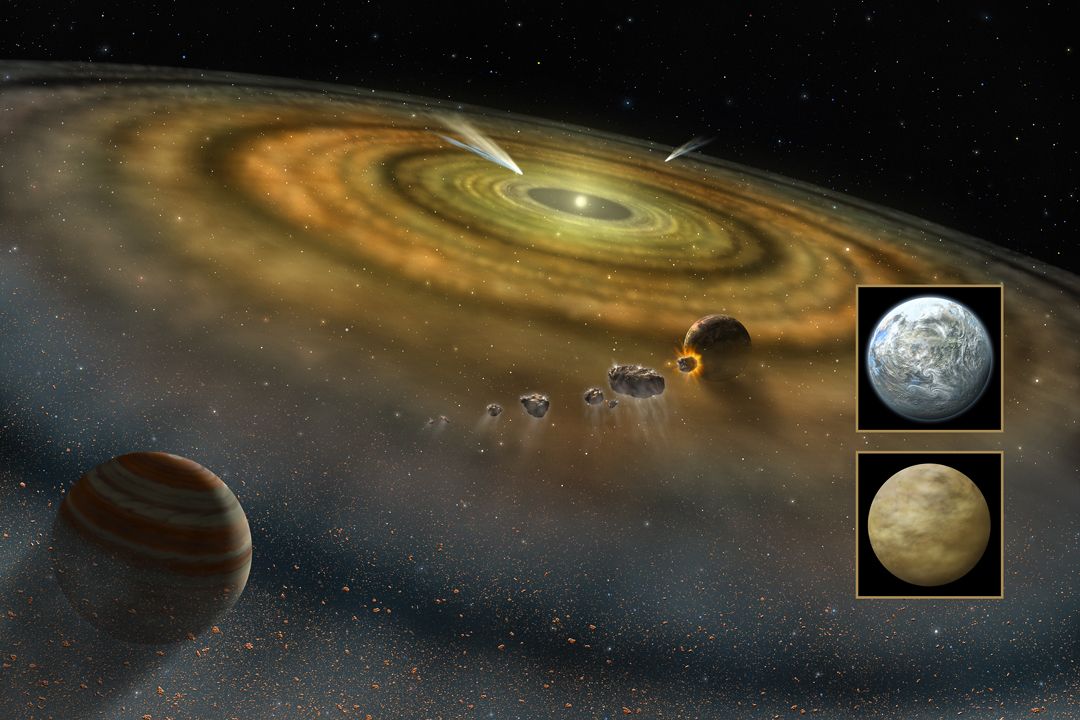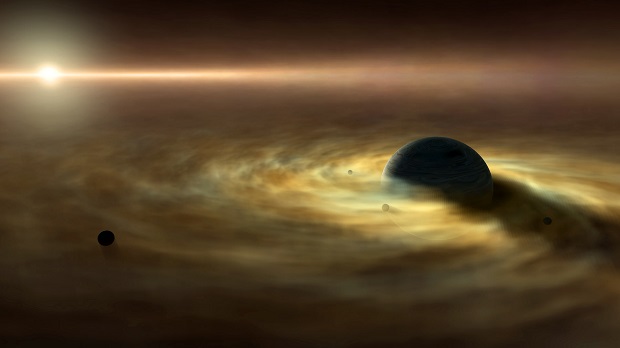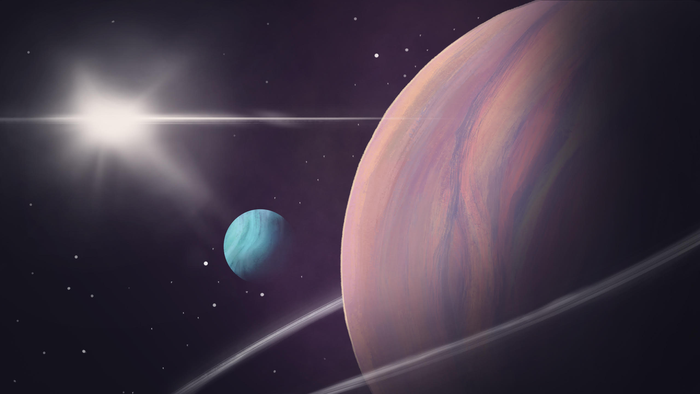
One of most interesting mysteries of space: Why are there rocky and icy satellites, but no gas ones?
The satellites of the planets in our solar system have a different composition: there are rocky satellites (for example, the Earth's Moon), oceanic satellites (for example, Europa, a moon of Jupiter, and Enceladus of Saturn), and moons made of ice (for example, Triton, a moon of Neptune). However, there are no gas satellites.
Why? Are there physical reasons why gas satellites cannot exist? Or is their absence just a matter of chance?
To understand why there are no gas satellites, at least not in our solar system, we must first understand how gas giant planets form. According to Space.com, there are two scenarios for the formation of such planets - “bottom-up” and “top-down”.
How do gas giants form? Two scenarios
The gas giants of the solar system, according to scientists, were formed according to a “bottom-up” scenario.
If we could go back in time 4.5 billion years, we would see the young Sun surrounded by a disk of gas and dust. This is the protoplanetary disk from which all planets were formed. First, rocky bodies began to appear, which absorbed dust, stones and asteroids and grew. Some reached the size of Mars or Venus, while others continued to grow, forming giant rocky bodies whose mass was 10 times the mass of the Earth.

Once they reached this mass, they had strong enough gravity to begin to attract large volumes of gas from the protoplanetary disk. As a result, the gas giant planets Jupiter and Saturn, as well as the cooler “ice giants” Uranus and Neptune, formed in the system.
NASA's Juno mission to Jupiter helped find evidence to support this particular scenario for the planet, finding at its center the gravity of a large, rocky but diffuse core that is about ten times the mass of Earth.
As for the top-down scenario, in this case, gas planets form directly from a collapsing accumulation of gas in a nebula, just as stars do. When a large lump of gas is compressed and compacted by its own gravity, it begins to heat up. But warm gas usually tends to expand, and in order to continue to contract, the gas “lump” must radiate excess heat. This is why we often see collapsing gas clouds with thermal infrared energy.
On the other hand, emitting enough heat so that the gas can cool enough and still continue to compress depends on the opacity of the dust, temperature and a number of other factors, and the efficiency of this process is also related to the size of the planet: if it is smaller than three times the mass of Jupiter, this process will not work as expected. This is why planets smaller than three Jupiter masses cannot form according to the top-down scenario.
Why are there no gas satellites in the Solar System?
Like their planets, most of the moons in our solar system were formed in a bottom-up scenario, as a result of core accretion into disks of residual material surrounding their parent planets (for obvious reasons, the second scenario could not work here). Because the planets had already consumed most of the available material, there simply wasn't enough to form moons so massive that they would have enough gravity to hold large amounts of gas. It is no coincidence that only one moon in the solar system has an atmosphere - and that is Titan, Saturn's largest moon.
It turns out that gas satellites of planets simply could not form in our system - under either of the two known scenarios.

Another interesting fact: the Moon most likely formed from material that was separated from the Earth after a collision with a protoplanet the size of Mars. Could an impact with a gas giant planet release enough gas to form a gas moon?
According to scientists, this is impossible. As Jessie Christiansen from the California Institute of Technology noted, rocky planets can, of course, collide with gaseous ones: this happened, for example, in 1994, when Comet Shoemaker-Levy 9 collided with Jupiter. But as a result of such collisions, rocky planets and comets are simply absorbed by gas giants and become part of them, and no debris is released into space from which a new moon could form.
Some moons are not formed from material separated from the planet, but are "captured" by the planet: for example, two of Mars' moons, Phobos and Deimos, are captured asteroids. Saturn's outermost moon Phoebus is a captured cometary object, and Neptune's moon Triton is a captured Kuiper Belt object. They all formed on their own in space, and then came too close and were captured by the gravity of the planets.
The question arises: can a small gaseous planet be captured by a larger gaseous planet and become its satellite? There is no clear answer to this question yet.
Do gaseous exomoons still exist?
Interestingly, gas satellites actually seem to exist! But -- not in the solar system. Although more than 5,500 exoplanets have been discovered so far, scientists have only been able to find two possible exomoons -- Kepler 1625b-i and Kepler 1708b-i, but neither of them is 100% confirmed yet. They are most likely gas giants orbiting even larger gas giants.

Kepler 1625b-i has 19 times the mass of Earth (about 6% of Jupiter's mass), and it accompanies a gaseous planet with 30 times the mass of Earth and half the diameter of Jupiter.
Kepler 1708b-i is likely less massive than Kepler-1625b-i, with a diameter about five times the size of Earth (about half that of Kepler-1625b-i), and it accompanies a giant planet 4. 6 times more massive than Jupiter.
According to scientists, it is unlikely that these two objects could have formed in one of the known ways; most likely, they formed as planets, and then they were “captured” by larger gas giants. In this case, it turns out that they are not true satellites, but rather an example of binary planets -- this is when two planets orbit around a common center of mass in the space between them, rather than one orbiting the other.
So, according to scientists, something like gas satellites may exist, but to create them, nature seems to have had to resort to cheating.
- Related News
- Wheel of Death: new method will help astronauts stay fit in low gravity
- Due to anomalies of Orion spacecraft, lunar exploration program may be delayed for years։ NASA
- TAO Observatory: World's highest telescope to study evolution of galaxies and exoplanets
- Powerful M9.5 solar flare causes radio blackout in Pacific Ocean
- What will happen to the Earth if the Moon disappears?
- Key to conquering the Red Planet: Why is NASA studying solar storms on Mars?
- Most read
month
week
day
- Digital Julfa Network is launching a pan-Armenian centre in the metaverse, on the Fastexverse virtual platform 901
- Sparkles: Boston Dynamics unveils a furry robot dog that can dance (video) 789
- Xiaomi unveils exclusive Redmi Note 13 Pro+ dedicated to Messi and Argentina national team 770
- Is there a ninth planet in the solar system? Scientists find new evidence 669
- Smartphone catches fire in child's hand in Russia 654
- What will happen to the Earth if the Moon disappears? 643
- How to understand how protected a smartphone is from water and dust? 633
- World's largest 3D printer was created in USL It prints 29 meter-long structures 619
- iPhone 16 may get colored matte glass back panel, 7 colors 608
- New iPad Pro to receive M4 chip and to be more powerful than Apple computers 605
- Archive
